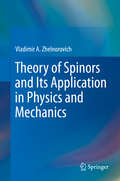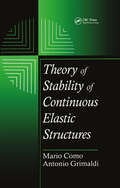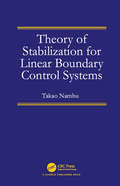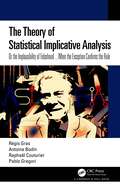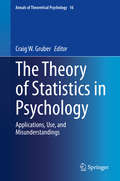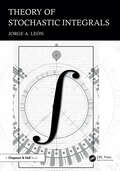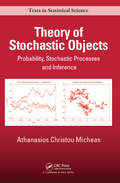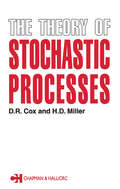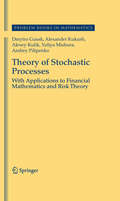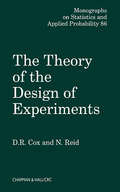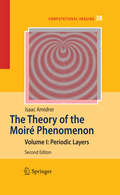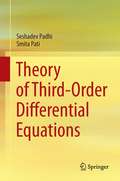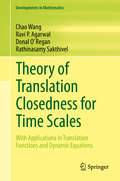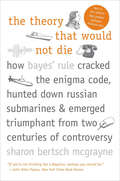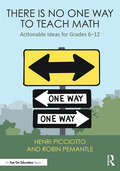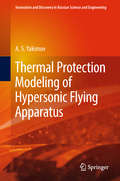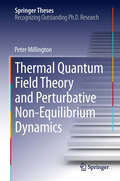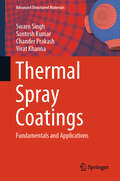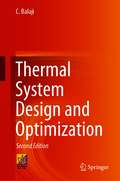- Table View
- List View
Theory of Spinors and Its Application in Physics and Mechanics
by Vladimir A. ZhelnorovichThis book contains a systematic exposition of the theory of spinors in finite-dimensional Euclidean and Riemannian spaces. The applications of spinors in field theory and relativistic mechanics of continuous media are considered. The main mathematical part is connected with the study of invariant algebraic and geometric relations between spinors and tensors. The theory of spinors and the methods of the tensor representation of spinors and spinor equations are thoroughly expounded in four-dimensional and three-dimensional spaces. Very useful and important relations are derived that express the derivatives of the spinor fields in terms of the derivatives of various tensor fields.The problems associated with an invariant description of spinors as objects that do not depend on the choice of a coordinate system are addressed in detail. As an application, the author considers an invariant tensor formulation of certain classes of differential spinor equations containing, in particular, the most important spinor equations of field theory and quantum mechanics. Exact solutions of the Einstein–Dirac equations, nonlinear Heisenberg’s spinor equations, and equations for relativistic spin fluids are given. The book presents a large body of factual material and is suited for use as a handbook. It is intended for specialists in theoretical physics, as well as for students and post-graduate students of physical and mathematical specialties.
Theory of Stability of Continuous Elastic Structures (Engineering Mathematics Ser.)
by Mario ComoTheory of Stability of Continuous Elastic Structures presents an applied mathematical treatment of the stability of civil engineering structures. The book's modern and rigorous approach makes it especially useful as a text in advanced engineering courses and an invaluable reference for engineers.
Theory of Stabilization for Linear Boundary Control Systems
by Takao NambuThis book presents a unified algebraic approach to stabilization problems of linear boundary control systems with no assumption on finite-dimensional approximations to the original systems, such as the existence of the associated Riesz basis. A new proof of the stabilization result for linear systems of finite dimension is also presented, leading to an explicit design of the feedback scheme. The problem of output stabilization is discussed, and some interesting results are developed when the observability or the controllability conditions are not satisfied.
The Theory of Statistical Implicative Analysis: Or the Implausibility of Falsehood ... When the Exception Confirms the Rule
by Régis Gras Antoine Bodin Raphaël Couturier Pablo GregoriThis book summarizes the methods and concepts of Statistical Implicative Analysis (SIA), created by Régis Gras in the 1980s to study, in a new way, the behavioural responses of French pupils to mathematics tests. Using a multidimensional, non-symmetrical data analysis method, SIA crosses a set of subjects or objects with a set of variables. It effectively complements traditional correlational and psychometric methods. SIA, through its various extensions, is today presented as a broad Artificial Intelligence method aimed at extracting trends and possible causalities in the form of rules, from a set of variables. It is based on the unlikeliness of the existence of these relationships, i.e. on the relative weakness of their counter-examples compared to what chance alone would produce. It establishes a dual topological relationship between the set of subjects and the set of variables. Many applications of this approach, driving forces or crucibles for the development of SIA, have concerned and still concern various fields such as didactics, evaluation and assessment, psychology, sociology, medicine, biology, economics, art history, and others. Key Features: Presents the foundations and representations of SIA. Provides extensions of variable sets and subjects. Includes a bonus exercise.
Theory of Statistical Inference (Chapman & Hall/CRC Texts in Statistical Science)
by Anthony AlmudevarTheory of Statistical Inference is designed as a reference on statistical inference for researchers and students at the graduate or advanced undergraduate level. It presents a unified treatment of the foundational ideas of modern statistical inference, and would be suitable for a core course in a graduate program in statistics or biostatistics. The emphasis is on the application of mathematical theory to the problem of inference, leading to an optimization theory allowing the choice of those statistical methods yielding the most efficient use of data. The book shows how a small number of key concepts, such as sufficiency, invariance, stochastic ordering, decision theory and vector space algebra play a recurring and unifying role. The volume can be divided into four sections. Part I provides a review of the required distribution theory. Part II introduces the problem of statistical inference. This includes the definitions of the exponential family, invariant and Bayesian models. Basic concepts of estimation, confidence intervals and hypothesis testing are introduced here. Part III constitutes the core of the volume, presenting a formal theory of statistical inference. Beginning with decision theory, this section then covers uniformly minimum variance unbiased (UMVU) estimation, minimum risk equivariant (MRE) estimation and the Neyman-Pearson test. Finally, Part IV introduces large sample theory. This section begins with stochastic limit theorems, the δ-method, the Bahadur representation theorem for sample quantiles, large sample U-estimation, the Cramér-Rao lower bound and asymptotic efficiency. A separate chapter is then devoted to estimating equation methods. The volume ends with a detailed development of large sample hypothesis testing, based on the likelihood ratio test (LRT), Rao score test and the Wald test. Features This volume includes treatment of linear and nonlinear regression models, ANOVA models, generalized linear models (GLM) and generalized estimating equations (GEE). An introduction to decision theory (including risk, admissibility, classification, Bayes and minimax decision rules) is presented. The importance of this sometimes overlooked topic to statistical methodology is emphasized. The volume emphasizes throughout the important role that can be played by group theory and invariance in statistical inference. Nonparametric (rank-based) methods are derived by the same principles used for parametric models and are therefore presented as solutions to well-defined mathematical problems, rather than as robust heuristic alternatives to parametric methods. Each chapter ends with a set of theoretical and applied exercises integrated with the main text. Problems involving R programming are included. Appendices summarize the necessary background in analysis, matrix algebra and group theory.
The Theory of Statistics in Psychology: Applications, Use, and Misunderstandings (Annals of Theoretical Psychology #16)
by Craig W. GruberThis edition of Annals of Theoretical Psychology focuses on the utilization of statistics and the empirical nature of them as applied to psychology in action. Beginning with statements from the American Statistical Association on the applicability of statistics, the volume moves to a discussion of empiricism in psychology, and the reliance on statistics. The book then branches out to discuss applied aspects of statistics in Emergency management, policing, and technology. In these areas, a tie-in to the relevance of the person in the statistical measures is a prominent aspect for discussion. Finally, the book looks at applicability and use of statistics as descriptors of larger, societal samples as opposed to use for describing individual behavior. This edition is designed to continue the exploration of theoretical psychology as it applies to behavior and the individual, as the last edition, Leader Development Deconstructed, did with examining leaders and leadership."Leaders influence others. Their tools include competence, candor and character. In those first two areas I’ve found statisticians possess a strong foundation for leadership (critical thinking, problem solving, strategic perspective, and risk management) but often lack a comfortable, collaborative temperament which inhibits their maximum effect. In this issue of Annals, Dr. Craig Gruber (a Navy Reserve Intelligence Officer to boot!) combines all three elements of influence which proves why he is regarded as a thought leader in this field. His inclusion in this edition of outstanding works from many subject matter experts’ offers an inclusive and comprehensive approach to understanding the power, impact, and decision advantage of statistics and leadership when effectively paired. Enjoy!"- Rear Admiral Paul Becker, USN (retired), President of The Becker T3 Group, and former Director of Intelligence for the Joint Chiefs of Staff
Theory of Stochastic Integrals
by Jorge A. LeónIn applications of stochastic calculus, there are phenomena that cannot be analyzed through the classical Itô theory. It is necessary, therefore, to have a theory based on stochastic integration with respect to these situations.Theory of Stochastic Integrals aims to provide the answer to this problem by introducing readers to the study of some interpretations of stochastic integrals with respect to stochastic processes that are not necessarily semimartingales, such as Volterra Gaussian processes, or processes with bounded p-variation among which we can mention fractional Brownian motion and Riemann-Liouville fractional process.Features Self-contained treatment of the topic Suitable as a teaching or research tool for those interested in stochastic analysis and its applications Includes original results.
Theory of Stochastic Objects: Probability, Stochastic Processes and Inference (Chapman & Hall/CRC Texts in Statistical Science)
by Athanasios Christou MicheasThis book defines and investigates the concept of a random object. To accomplish this task in a natural way, it brings together three major areas; statistical inference, measure-theoretic probability theory and stochastic processes. This point of view has not been explored by existing textbooks; one would need material on real analysis, measure and probability theory, as well as stochastic processes - in addition to at least one text on statistics- to capture the detail and depth of material that has gone into this volume. Presents and illustrates ‘random objects’ in different contexts, under a unified framework, starting with rudimentary results on random variables and random sequences, all the way up to stochastic partial differential equations. Reviews rudimentary probability and introduces statistical inference, from basic to advanced, thus making the transition from basic statistical modeling and estimation to advanced topics more natural and concrete. Compact and comprehensive presentation of the material that will be useful to a reader from the mathematics and statistical sciences, at any stage of their career, either as a graduate student, an instructor, or an academician conducting research and requiring quick references and examples to classic topics. Includes 378 exercises, with the solutions manual available on the book's website. 121 illustrative examples of the concepts presented in the text (many including multiple items in a single example). The book is targeted towards students at the master’s and Ph.D. levels, as well as, academicians in the mathematics, statistics and related disciplines. Basic knowledge of calculus and matrix algebra is required. Prior knowledge of probability or measure theory is welcomed but not necessary.
The Theory of Stochastic Processes
by D.R. CoxThis book should be of interest to undergraduate and postgraduate students of probability theory.
Theory of Stochastic Processes
by Dmytro Gusak Andrey Pilipenko Alexander Kukush Yuliya Mishura Alexey KulikThis book is a collection of exercises covering all the main topics in the modern theory of stochastic processes and its applications, including finance, actuarial mathematics, queuing theory, and risk theory. The aim of this book is to provide the reader with the theoretical and practical material necessary for deeper understanding of the main topics in the theory of stochastic processes and its related fields. The book is divided into chapters according to the various topics. Each chapter contains problems, hints, solutions, as well as a self-contained theoretical part which gives all the necessary material for solving the problems. References to the literature are also given. The exercises have various levels of complexity and vary from simple ones, useful for students studying basic notions and technique, to very advanced ones that reveal some important theoretical facts and constructions. This book is one of the largest collections of problems in the theory of stochastic processes and its applications. The problems in this book can be useful for undergraduate and graduate students, as well as for specialists in the theory of stochastic processes.
The Theory of the Design of Experiments (Chapman & Hall/CRC Monographs on Statistics and Applied Probability)
by D.R. Cox Nancy ReidWhy study the theory of experiment design? Although it can be useful to know about special designs for specific purposes, experience suggests that a particular design can rarely be used directly. It needs adaptation to accommodate the circumstances of the experiment. Successful designs depend upon adapting general theoretical principles to the spec
The Theory of the Moiré Phenomenon
by Isaac AmidrorThis book presents the most comprehensive and methodical work on the theory of the moiré phenomenon, providing a full general-purpose and application-independent exposition of this fascinating effect. Based on the Fourier theory, it leads the reader through the various phenomena which occur in the superposition of repetitive layers, both in the image and in the spectral domains. The first chapters of the book present the basic theory, covering the superposition of monochrome, periodic layers. In later chapters, the theory is extended to the even more interesting cases of polychromatic moirés and moirés between repetitive, non-periodic layers. Throughout the whole text the book favours a pictorial, intuitive approach, which is supported by mathematics, and the discussion is accompanied by a large number of figures and illustrative examples. The prerequisite mathematical background is limited to an elementary familiarity with the Fourier theory.
Theory of the Spread of Epidemics and Movement Ecology of Animals: An Interdisciplinary Approach using Methodologies of Physics and Mathematics
by V. M. Kenkre Luca GiuggioliExploiting powerful techniques from physics and mathematics, this book studies animal movement in ecology, with a focus on epidemic spread. Pulmonary syndrome is not only feared in epidemics of recent times, such as COVID-19, but is also characteristic of epidemics studied earlier such as Hantavirus. The Hantavirus is one of the book's central topics. Correlations between epidemic outbreaks and precipitation events like El Niño are analyzed and spatial reservoirs of infection in off-period of the epidemic, known as refugia, are studied. Predicted traveling waves of infection are successfully compared to field observations. Territoriality in scent-marking animals is presented, with parallels drawn with the theory of melting. The flocking and herding of birds and mammals are described in terms of collective excitations. For scientists interested in movement ecology and epidemic spread, this book provides effective solutions to long-standing problems.
Theory of Thermodynamic Measurements of Quantum Systems Far from Equilibrium (Springer Theses)
by Abhay ShastryThis thesis presents several related advances in the field of nonequilibrium quantum thermodynamics. The central result is an ingenious proof that the local temperature and voltage measurement in a nonequilibrium system of fermions exists and is unique, placing the concept of local temperature on a rigorous mathematical footing for the first time. As an intermediate step, a proof of the positivity of the Onsager matrix of linear response theory is given -- a statement of the second law of thermodynamics that had lacked an independent proof for 85 years. A new experimental method to measure the local temperature of an electron system using purely electrical techniques is also proposed, which could enable improvements to the spatial resolution of thermometry by several orders of magnitude. Finally, a new mathematically-exact definition for the local entropy of a quantum system in a nonequilibrium steady state is derived. Several different measures of the local entropy are discussed, relating to the thermodynamics of processes that a local observer with varying degrees of information about the microstates of the system could carry out, and it is shown that they satisfy a hierarchy of inequalities. Proofs of the third law of thermodynamics for generic open quantum systems are presented, taking into account the entropic contribution due to localized states. Appropriately normalized (per-state) local entropies are defined and are used to quantify the departure from local equilibrium.
Theory of Third-Order Differential Equations
by Seshadev Padhi Smita PatiThis book discusses the theory of third-order differential equations. Most of the results are derived from the results obtained for third-order linear homogeneous differential equations with constant coefficients. M. Gregus, in his book written in 1987, only deals with third-order linear differential equations. These findings are old, and new techniques have since been developed and new results obtained. Chapter 1 introduces the results for oscillation and non-oscillation of solutions of third-order linear differential equations with constant coefficients, and a brief introduction to delay differential equations is given. The oscillation and asymptotic behavior of non-oscillatory solutions of homogeneous third-order linear differential equations with variable coefficients are discussed in Ch. 2. The results are extended to third-order linear non-homogeneous equations in Ch. 3, while Ch. 4 explains the oscillation and non-oscillation results for homogeneous third-order nonlinear differential equations. Chapter 5 deals with the z-type oscillation and non-oscillation of third-order nonlinear and non-homogeneous differential equations. Chapter 6 is devoted to the study of third-order delay differential equations. Chapter 7 explains the stability of solutions of third-order equations. Some knowledge of differential equations, analysis and algebra is desirable, but not essential, in order to study the topic.
Theory of Translation Closedness for Time Scales: With Applications in Translation Functions and Dynamic Equations (Developments in Mathematics #62)
by Chao Wang Ravi P. Agarwal Rathinasamy Sakthivel Donal O' ReganThis monograph establishes a theory of classification and translation closedness of time scales, a topic that was first studied by S. Hilger in 1988 to unify continuous and discrete analysis. The authors develop a theory of translation function on time scales that contains (piecewise) almost periodic functions, (piecewise) almost automorphic functions and their related generalization functions (e.g., pseudo almost periodic functions, weighted pseudo almost automorphic functions, and more). Against the background of dynamic equations, these function theories on time scales are applied to study the dynamical behavior of solutions for various types of dynamic equations on hybrid domains, including evolution equations, discontinuous equations and impulsive integro-differential equations.The theory presented allows many useful applications, such as in the Nicholson`s blowfiles model; the Lasota-Wazewska model; the Keynesian-Cross model; in those realistic dynamical models with a more complex hibrid domain, considered under different types of translation closedness of time scales; and in dynamic equations on mathematical models which cover neural networks. This book provides readers with the theoretical background necessary for accurate mathematical modeling in physics, chemical technology, population dynamics, biotechnology and economics, neural networks, and social sciences.
The Theory That Would Not Die: How Bayes' Rule Cracked the Enigma Code, Hunted Down Russian Submarines, & Emerged Triumphant from Two Centuries of C
by Sharon Bertsch McGrayne"This account of how a once reviled theory, Baye&’s rule, came to underpin modern life is both approachable and engrossing" (Sunday Times). A New York Times Book Review Editors&’ Choice Bayes' rule appears to be a straightforward, one-line theorem: by updating our initial beliefs with objective new information, we get a new and improved belief. To its adherents, it is an elegant statement about learning from experience. To its opponents, it is subjectivity run amok. In the first-ever account of Bayes' rule for general readers, Sharon Bertsch McGrayne explores this controversial theorem and the generations-long human drama surrounding it. McGrayne traces the rule&’s discovery by an 18th century amateur mathematician through its development by French scientist Pierre Simon Laplace. She reveals why respected statisticians rendered it professionally taboo for 150 years—while practitioners relied on it to solve crises involving great uncertainty and scanty information, such as Alan Turing's work breaking Germany's Enigma code during World War II. McGrayne also explains how the advent of computer technology in the 1980s proved to be a game-changer. Today, Bayes' rule is used everywhere from DNA de-coding to Homeland Security. Drawing on primary source material and interviews with statisticians and other scientists, The Theory That Would Not Die is the riveting account of how a seemingly simple theorem ignited one of the greatest controversies of all time.
There Is No One Way to Teach Math: Actionable Ideas for Grades 6–12
by Robin Pemantle Henri PicciottoA collaboration between a seasoned math teacher and a research mathematician, this resource offers balanced instructional ideas based on student intellectual engagement and skilled teacher leadership. It is solidly grounded in many areas of classroom practice, but rather than serving as a prescriptive how-to manual, the authors invite reflection and discussion across classrooms and math departments, much in the way you would share ideas in the teachers’ lounge or across the table at a conference.Chapters offer practical suggestions and concrete examples to teachers of grades 6–12 on just about every aspect of the job: manipulatives, technology, lesson planning, group work, classroom discussion, and more. In opposition to the idea of a “one-size-fits-all” curriculum, the authors explain how to integrate teaching techniques: formal and informal, student-centered and teacher-led, experiential and rigorous.Chapters also include vignettes, as well as many links to curricular materials. Ideal for math educators of grades 6–12, this book is both comprehensive in its strategies and sensitive to the complexities of teaching. For these reasons, math departments, coaches, teacher leaders, and faculty at other levels can also easily reference its content where relevant. This book offers multiple entry points for teachers and departments to discuss and enhance their practice, making it essential reading for any math educator or professional development opportunity.
There's Math in My Origami!: 35 Fun Projects For Hands-on Math Learning
by Fumiaki Shingu35 creative origami designs plus brain-teasing math questions add up to the perfect math activity for kids Discover how fractions, shapes, and symmetry turn a flat sheet of paper into a 3D work of art! Each one of the 35 amazing projects in There’s Math in My Origami!invites kids to: Follow the simple, step-by-step instructions Flex their math skills by answering a fun quiz question Fold adorable origami like they’ve never seen before! Includes educational projects for kids ages 7 and up—plus 2 pages of eye stickers, and 80 sheets of origami paper!
Thermal and Statistical Physics: Concepts and Applications
by Sandeep SharmaThis textbook presents the fundamental concepts and theories in thermal physics and elementary statistical mechanics in a very simple, systematic and comprehensive way. This book is written in a way that it presents the topics in a holistic manner with end-of-chapter exercises and examples where concepts are supported by numerous solved examples and multiple-choice questions to aid self-learning. The textbook also contains illustrated diagrams for better understanding of the concepts. The book will benefit students who are taking introductory courses in thermal physics, thermodynamics and statistical mechanics.
Thermal Distribution Principle and Nonlinear Optimal Control for HVAC Water System (Indoor Environment and Sustainable Building)
by Tianyi Zhao Jiaming Wang Yiting WangThis book introduces the intelligent control technology of heating ventilation and air conditioning (HVAC) water system in detail, studying its thermal distribution characteristics and optimal control methods combining the nonlinearity, strong coupling and delay characteristics to improve the overall operation and maintenance level as well as the energy efficiency of HVAC water system. Intelligent control technology of HVAC water systems involves various fields such as electrical, mechanical, environmental and civil engineering. The book establishes a basic research framework for this topic using a sub-total approach, emphasizing the importance of thermodynamic properties and the significant influence of nonlinear properties in the optimal control of the system. This book is intended for undergraduate and postgraduate students interested in automated control of HVAC water systems, researchers investigating methods for system energy conservation and optimization and design engineers working on intelligent operation and maintenance of HVAC water system.
Thermal Protection Modeling of Hypersonic Flying Apparatus (Innovation And Discovery In Russian Science And Engineering Ser.)
by A. S. YakimovThis book is devoted to studies of unsteady heat and mass exchange processes taking into account thermochemical destruction of thermal protective materials, research of transpiration cooling systems, thermal protection of composite materials exposed to low-energy disturbances, as well as the numerical solution of heat and mass transfer of the exchange. It proposes several mathematical models of passive and active thermal protection systems with regard to factors such as surface ablation, surface roughness, phase transition of a liquid in porous materials, rotation of the body around its longitudinal axis, and exposure to low-energy disturbances. The author studies the possibilities to control thermochemical destruction and heat mass exchange processes in transpiration cooling systems exposed to low-energy disturbances. The numerical analysis of the heat and mass exchange process in carbon plastics under repeated impulse action is also presented. The numerical solutions of problems are compared with the known experimental data. The book is intended for specialists in the field of thermal protection and heat mass exchange, as well as graduate and undergraduates in physics and mathematics.
Thermal Quantum Field Theory and Perturbative Non-Equilibrium Dynamics
by Peter MillingtonThe author develops a new perturbative formalism of non-equilibrium thermal quantum field theory for non-homogeneous backgrounds. As a result of this formulation, the author is able to show how so-called pinch singularities can be removed, without resorting to ad hoc prescriptions, or effective resummations of absorptive effects. Thus, the author arrives at a diagrammatic approach to non-equilibrium field theory, built from modified Feynman rules that are manifestly time-dependent from tree level. This new formulation provides an alternative framework in which to derive master time evolution equations for physically meaningful particle number densities, which are valid to all orders in perturbation theory and to all orders in gradient expansion. Once truncated in a loop-wise sense, these evolution equations capture non-equilibrium dynamics on all time-scales, systematically describing energy-violating processes and the non-Markovian evolution of memory effects
Thermal Spray Coatings: Fundamentals and Applications (Advanced Structured Materials #232)
by Swarn Singh Santosh Kumar Chander Prakash Virat KhannaThis book provides a comprehensive review of the effects of key factors ranging from powder characteristics to process parameters, substrate preparation, and post-treatment methods on the coated substrate surface by different thermal spray techniques. Thermal spray techniques have gained significant attention in various industries due to their ability to deposit protective coatings on substrates. These coatings enhance the surface properties of substrates, such as wear resistance, corrosion resistance, and thermal insulation. However, the quality and performance of the coated substrate surface are influenced by several key factors. The book discusses the influence of parameters such as powder characteristics, process parameters, substrate preparation, and post-treatment methods on the coating microstructure, adhesion, and overall performance. The review aims to contribute to a better understanding of the factors that affect the coated substrate surface and provide insights for future research and optimization of thermal spray processes.
Thermal System Design and Optimization
by C. BalajiThis highly informative and carefully presented textbook introduces the general principles involved in system design and optimization as applicable to thermal systems, followed by the methods to accomplish them. It introduces contemporary techniques like Genetic Algorithms, Simulated Annealing, and Bayesian Inference in the context of optimization of thermal systems. There is a separate chapter devoted to inverse problems in thermal systems. It also contains sections on Integer Programming and Multi-Objective optimization. The linear programming chapter is fortified by a detailed presentation of the Simplex method. A major highlight of the textbook is the inclusion of workable MATLAB codes for examples of key algorithms discussed in the book. Examples in each chapter clarify the concepts and methods presented and end-of-chapter problems supplement the material presented and enhance the learning process.
